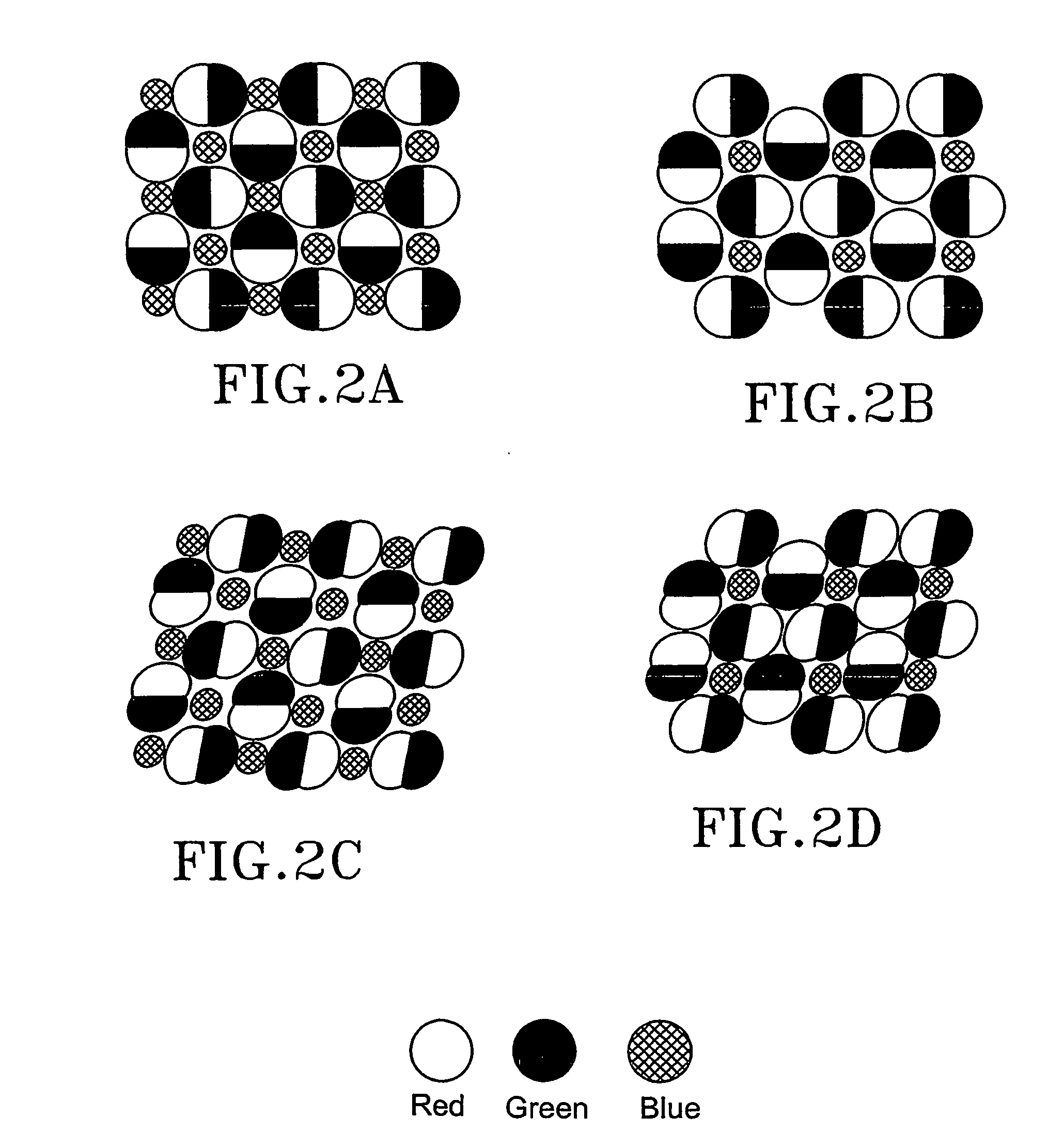Pixel patterns
a technology of pixel pattern and pattern, applied in the field of electronic imaging devices, can solve the problems of insufficient high resolution, inability to achieve uncomplicated solutions, and pixel regularity holds the danger of aliasing, so as to minimise the risk and minimise the risk
- Summary
- Abstract
- Description
- Claims
- Application Information
AI Technical Summary
Benefits of technology
Problems solved by technology
Method used
Image
Examples
first embodiment
A First Embodiment
Square Pattern
[0057] According to a first embodiment of this invention shown in FIG. 2A the risk of such aliasing is reduced. The pixel array illustrated in FIG. 2A is composed of double pixels and single pixels, which occur in about a 1 double:1 single pixel ratio in an array of pixels. It is preferred that the single pixels represent a blue colour, whereas the two pixels in the double pixel represent a red colour and a green colour respectively. Said pixels may in other embodiments represent other colours, depending on the specific application, the surrounding environment etc. An example of other possible colours is the complementary colours cyan, magenta and yellow.
[0058] The pixels in the first embodiment are arranged in a “square pattern”, where four double pixels occupy the sides of a square. A first double pixel is horizontally arranged at the bottom of the square, while three further double pixels are preferably arranged at the remaining sides of the squa...
second embodiment
A Second Embodiment
Shifted Square Pattern
[0065] According to a second embodiment of this invention shown in FIG. 2B the risk of aliasing is reduced in a similar way as in the previously discussed first embodiment of this invention as shown in FIG. 2A.
[0066] The pixel array illustrated in FIG. 2B is composed of double pixels and single pixels, which occur in about a 2 double:1 single pixel ratio in an array of pixels. In this embodiment, as In the first embodiment, it is preferred that the single pixels represent a blue colour, whereas the two pixels in the double pixel represent a red colour and a green colour respectively. Said pixels may in other embodiments represent other colours, depending on the specific application, the surrounding environment etc. An example of other possible colours is the complementary colours cyan, magenta and yellow.
[0067] The pixels in the second embodiment are arranged in a square pattern where four double pixels occupy the sides of a square, much i...
third embodiment
A Third Embodiment
Shifted Square Pattern
[0077] According to a third embodiment of this invention shown in FIG. 2E the risk of aliasing is reduced in a similar way as in the previously discussed second embodiment of this invention as shown in FIG. 2B.
[0078] In the third embodiment, as in the second embodiment, the pixel array illustrated in FIG. 2E is composed of double pixels and single pixels, which occur in about a 2 double:1 single pixel ratio in an array of pixels. In this embodiment, as in the second embodiment, it is preferred that the single pixels represent a blue colour, whereas the two pixels in the double pixel represent a red colour and a green colour respectively.
[0079] The pixels in the third embodiment are arranged in a “shifted square pattern” where four double pixels occupy the sides of a square in a similar way as in the previously discussed second embodiment. Consequently, a first double pixel is horizontally arranged at the bottom of the square, while three fu...
PUM
| Property | Measurement | Unit |
|---|---|---|
| crossing angles | aaaaa | aaaaa |
| angle | aaaaa | aaaaa |
| turning angles | aaaaa | aaaaa |
Abstract
Description
Claims
Application Information
 Login to View More
Login to View More - R&D
- Intellectual Property
- Life Sciences
- Materials
- Tech Scout
- Unparalleled Data Quality
- Higher Quality Content
- 60% Fewer Hallucinations
Browse by: Latest US Patents, China's latest patents, Technical Efficacy Thesaurus, Application Domain, Technology Topic, Popular Technical Reports.
© 2025 PatSnap. All rights reserved.Legal|Privacy policy|Modern Slavery Act Transparency Statement|Sitemap|About US| Contact US: help@patsnap.com



